Rhagoletis completa
Walnuts have entranced societies for thousands of years with their beauty and shade – not to mention their delectable and extremely healthy nuts and valuable wood.
However, there is a dark side to growing walnuts, and it comes in the form of a 1/4 inch long insect – the walnut husk fly (Rhagoletis completa).
This is the most common pest encountered in both backyard and commercial groves of walnut trees on the West Coast – and a serious problem for growers.
Technically, it’s the maggots that are the problem. They feed on the husk that surrounds the nut.

We link to vendors to help you find relevant products. If you buy from one of our links, we may earn a commission.
The severity of the damage depends on when the larvae feed. It can range from the discoloration of the shell to the destruction of the kernel.
Even worse, the kernel may grow mold. You may think of mold as just unpleasant, but this kind of fungus produces a dangerous carcinogen called aflatoxin.
And the walnut husk fly is becoming an even more serious problem by showing up much earlier in the season than normal – before the growers are ready for it.
We at Gardener’s Path will walk you through the steps to monitor and protect your walnut tree – and when you will need to hire a professional pest control expert.
What You Will Learn
- Identification, Life Cycle and Distribution
- Susceptible Walnut Species and Cultivars
- The Walnut Husk Fly is Spreading!
- Effects on Walnuts
- How to Monitor Adult Walnut Husk Flies
- Control
- Inspect Your Walnuts for Stings
- Sanitation in the Fall
- Selectively Harvest Your Walnuts
- Monitoring the Flies is Critical For a Healthy Crop
Identification, Life Cycle and Distribution
The walnut husk fly (WHF) looks so striking that it is easy to identify. It is the size of a housefly but brown with a yellow semicircle on its back. And then there are its unique translucent wings – with large brownish-black bands on them.
Adults emerge from the soil from May to early fall and mate within 1-2 weeks. The females then lay eggs just below the walnut husk’s surface.
The larvae hatch into white maggots in 5-7 days, and trouble really begins!
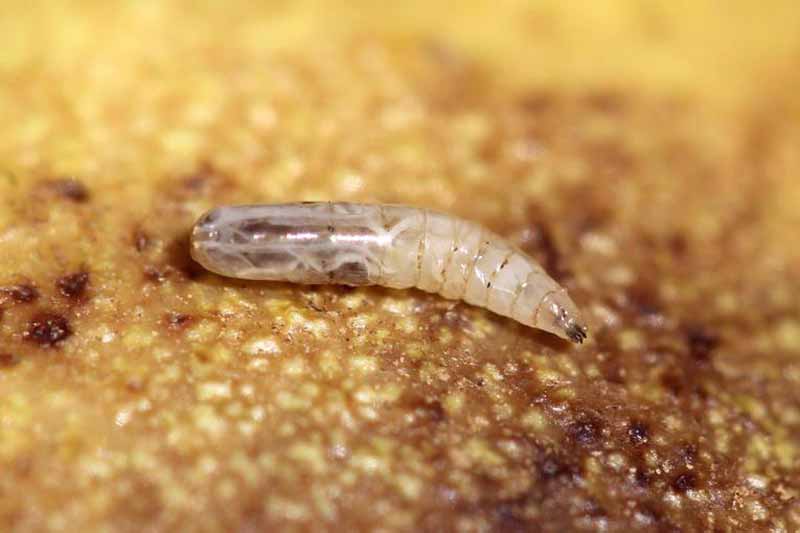
These 1/2-inch maggots feed on the flesh of the husk. The larvae become yellow with black mouthparts as they mature.
As they eat, the process releases the pigment in the walnuts. This compound goes on to stain the shell and change the flavor of the kernel.
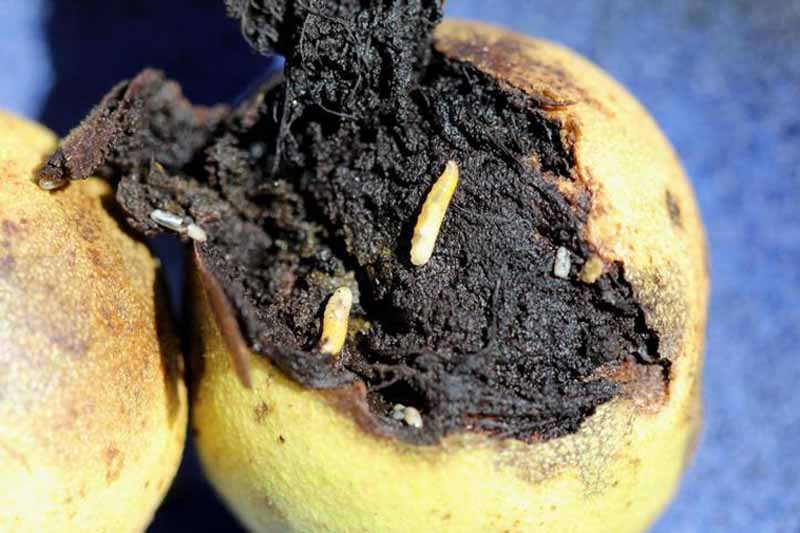
Worst-case scenario – the husks stick to the shells. This can lead to shriveled and moldy kernels.
Eventually these infested walnuts fall to the ground, and the maggots burrow into the soil and pupate for 1-2 years.
Unfortunately, the soil keeps these pupae safe from the elements – and also most predators.
WHF are native to the southern and central US but spread to the west in the 1920s. Currently, they are a serious problem in California and Washington State where the bulk of US English walnut prodcution occurs.
Originally a quarantine pest in Europe, the flies became naturalized in southern Europe in the early 1990s.
Susceptible Walnut Species and Cultivars
Preferred hosts for the WHF include black walnuts and all cultivars of English walnut.
Particularly susceptible English walnut cultivars include Franquette, Hartley, Serr, and Tulare.
It can be important to know what cultivar you are growing because some cultivars incur damage earlier in the season than others.
For example, the flies attack the Hartley, Payne, and Serr cultivars earlier than Chandler.
The Walnut Husk Fly is Spreading!
University of California, Berkeley Emeritus Professor and walnut husk fly expert Bob Van Steenwyk told GrowingProduce.com that the pest is becoming a problem in new areas.
In the Sacramento Valley in California, June 1 used to be when you would put your first trap out.
Now the pests are arriving earlier in the season – possibly due to the warming of the climate. So you may want to start trapping as early as May 1 in the Golden state.
Effects on Walnuts
The symptoms of this infestation vary depending on when the larvae attack the husk.
If the infestations are early in the season, the nuts will still be developing. So the kernels themselves get damaged, and there is the potential for you to lose your whole crop.
Early infestations are much more likely to produce the toxic mold growth along with shriveled and darkened kernels.

Later infestations stain the shell. The walnut stain won’t bleach out well, so you won’t be able to sell your walnuts in-shell.
However, at least the kernel will retain its quality, so if you are growing walnuts to eat, you should be good to go.
The problem may be that it may be difficult to remove the hull.
However, you can get around that by putting the nuts in a damp burlap bag for several days. It should be easier to remove the hull after that.
How to Monitor Adult Walnut Husk Flies
Unfortunately, since the eggs and larvae are hidden within the husk, they are protected from insecticides.
You have to focus your monitoring efforts on the adults, since they are the key stage to control.
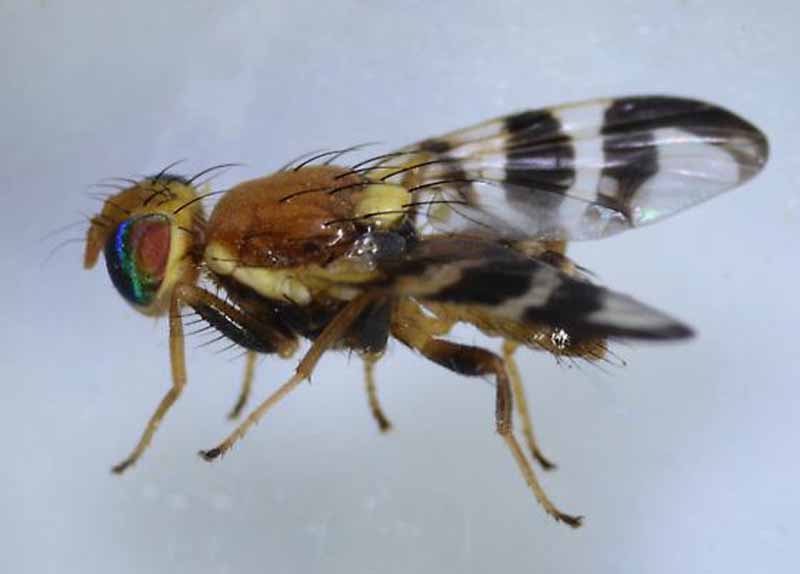
There is only a short time window to detect the adults before they start laying eggs.
Once the eggs have been laid within the husk, the larvae will develop where you cannot reach them.

The size of mature walnut trees can make it difficult for homeowners to monitor and control walnut husk flies. It is not unheard of for residential walnut trees to be 120 feet tall!
Treating a tree that size will pose problems with pesticide drift. So if you have a large tree, you should consult with a licensed professional.
However, if you have a tree that is 10-feet tall or smaller, you can carry out all these steps yourself.
You may be familiar with yellow sticky traps. That is what you can use to look for adult flies.
According to the University of Californis Integrated Pest Management Program, you will want to get unbaited yellow sticky traps designed for apple maggots (Pherocon AM NB) that have been super-charged with ammonium carbonate to attract the adult flies.
What is Integrated Pest Management?
IPM is an ecosystem-focused style of management that allows you to manage your pests more sustainably, helping you to use less harmful pesticides whilst having the added bonus of helping you to get to know our gardens more intimately.
Do not use apple maggot traps that already contain bait because they will not attract the WHF.
Ideally, you should put the trap in the upper half of the canopy on the north side of the trees and at least six feet off the ground.
Monitor your traps at least twice a week and preferably more frequently.
You want to detect the adults ASAP, so you can kill them before they start laying the eggs that produce the menacing larvae.
Remove the flies and put them on a dark background.
Look for females – they are the ones with the yellow front legs. (You can see this with a 10X hand lens.)
Then check if the female is carrying eggs by gently squeezing her abdomen. The eggs look like small grains of rice.
Even if you didn’t detect any flies in the previous year, you should keep monitoring because they can live in the soil for two years.
Or they may come from your neighbor’s tree! Share and share alike.
Control
You will have to apply some sort of insecticide to control these pests and protect your walnuts.
A bad infestation could cause you to lose your entire crop of in-shell nuts. They will be worthless if they are not shelled.
If you grow a shelled cultivar, you could lose half the value of your crop.
It is critical that you apply an insecticide ASAP after detecting eggs.
Unfortunately, you will need to keep spraying until 1-2 weeks before the hulls split.
Organic Insecticide/Bait
You can buy the organically certified product GF-120 that contains the natural insecticide spinosad along with bait that attracts the flies.
GF-120 is as effective as traditional insecticides, but it doesn’t cause the typical negative effects of aphids or mites flaring up.
However, you do have to apply it earlier than conventional insecticides because it has to be consumed before it can kill the flies.
You should start spraying as soon as you detect any flies.
Growers spray this treatment 20-feet high from the back of an ATV, but you can use conventional means to spray a smaller tree.
You can also use the Entrust formulation, but you must mix with it with bait that is organic.
Conventional Insecticide/Bait
If you have a large population of WHF, you may want to start spraying with conventional insecticides mixed with bait.
One problem with GF-120 is that if you have an enormous quantity of flies, they will eat all the bait.
In the GrowingProduce.com article, Dr. Van Steenwyk recommended that growers who are faced with a large population start with a conventional insecticide to reduce the populations and then switch to GF-120 as the WHF populations get lower.
With conventional insecticides, you can wait to spray until you see an increase in the number of flies in your traps.
These types of sprays will typically provide control for about 3 weeks after application.
Baits that you can use include molasses, NU-Lure Bait, and Brandt Insect Bait.
Insecticides that are the most effective at killing adult WHF and have minimal impact on bees, natural enemies, and the environment include:
- Acetamiprid – effective for 14 days (do not spray around bees)
- Bifenthrin – effective for 21-28 days
- Beta-cylfuthrin – effective for 14 days
- Lambda-cyhalothrin – effective for 14 days
Inspect Your Walnuts for Stings
When the female injects the eggs into the walnut, dark juice will flow from the puncture site.
That results in a distinctive teardrop-sized stain on the nut known as a “sting.”
You should look for these stings after you have started detecting flies in the traps.
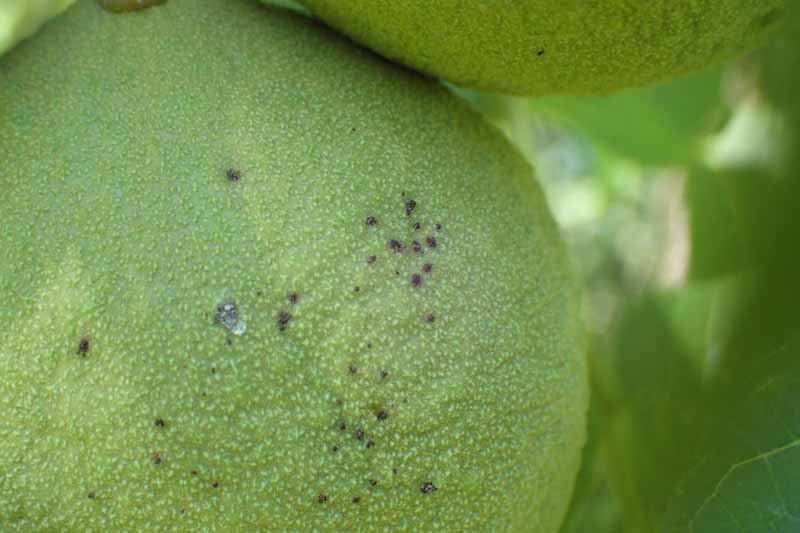
Check at least 10 nuts on the north side of your tree. If you see fresh stings, you know that your infestation is still in progress and that you should continue spraying.
It is also valuable to check some nuts right before harvest. This is a good way to assess the damage to your walnuts and to determine which trees had more severe infestations.
Then you will know that you need to place traps on them next year.
Sanitation in the Fall
For damage control after the fact, you should put a tarp under your tree to catch the walnuts that fall and contain maggots, so they won’t spread into the soil.
If you do find infested walnuts, be sure and throw them out in the trash. Do not compost them!
It is important to rake after you have harvested your walnuts. Throw out any nuts that haven’t been harvested in case they contain mature maggots.
Selectively Harvest Your Walnuts
When you harvest your walnuts, avoid the ones that are darker in color because they might be infested. You should collect the green-husked walnuts that look more fresh.
And de-husk your walnuts as quickly as you can.
Monitor all your fallen walnuts. Check the husk for a soft brown spot.
If you find one, crack open the walnut and look for eggs and larvae.
Monitoring the Flies is Critical For a Healthy Crop
The walnut husk fly is a highly destructive walnut pest that is difficult to control.
The insect spends much of its time in the ground as pupae, and it is untouchable when it is in its larval stage inside the husk.
Walnut-Husk-Fly-Control-Cover
You only have a few weeks to detect the flies and spray them with insecticides, and monitoring with sticky traps is the key factor that will tell you whether you should spray or not.
You will need to remain vigilant because the flies can stay in the ground for two years or more.
However, if you take the right precautions, you can have a good crop of walnuts.
Have you had success fighting walnut husk flies? If so, let us know in the comments.
© Ask the Experts, LLC. ALL RIGHTS RESERVED. See our TOS for more details.
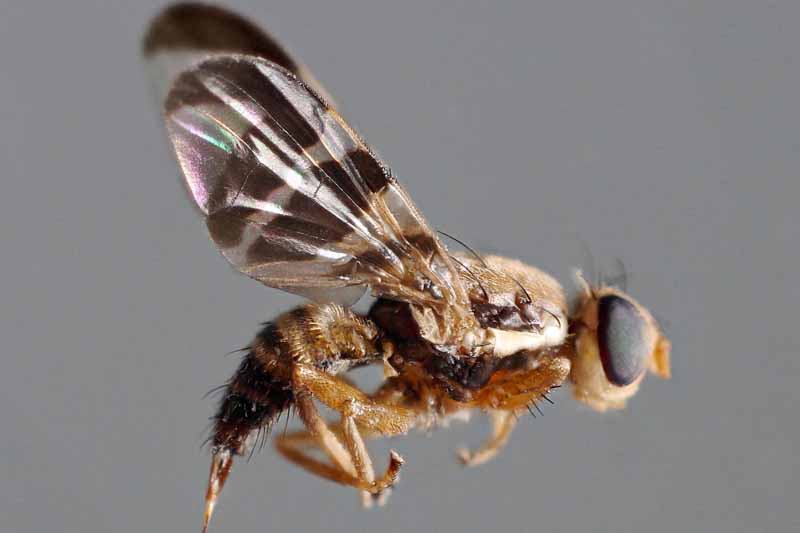
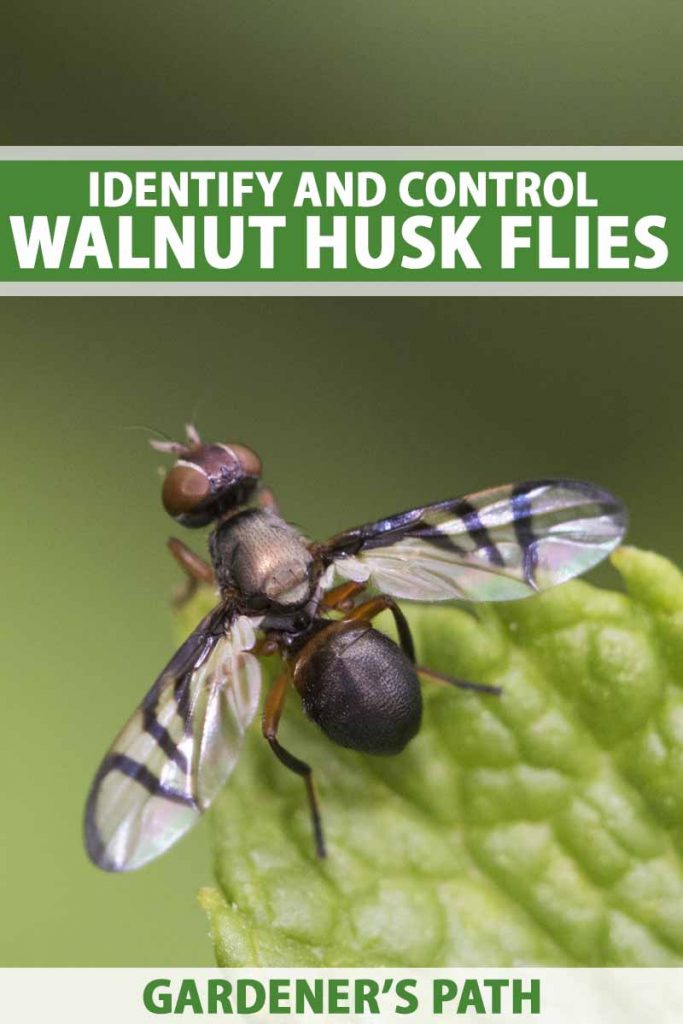
I have collected A TON of black walnuts, apparently they have mold on the green husk, are they now bad?
And if I find worms in the husk, should I throw out the whole nut? Or just scrape off the worms and use the husks?
Thank you
Dear Rey, Thanks for your questions! If there are worms in the husk, you should definitely discard the nuts. The worms predispose the walnuts to the growth of fungi, which can produce carcinogenic toxins. And for that reason, you should also discard the black walnuts with mold on the green husk.
I have a problem with walnut husk flies in a screened in porch at our house (Rochester, NY). We have 3 large black walnut trees on our property. I think squirrels have stored black walnuts under the deck upon which the screened in porch sits, and the flies are somehow coming up through the gaps in the deck boards even though the deck is covered with indoor outdoor carpet. The flies can’t get out of the screened in porch, so hundreds of them crawl/fly around and end up dead on the floor. I rarely notice any flies outside of the… Read more »
Hi Loren,
That sounds dreadful! There are some compounds that would be suitable to spray in a place like that. I would recommend neem oil. It has been used for thousands of years and has a good safety record. You should be able to buy it at your local garden center. If you want to order it online, you can buy Bonide neem oil from Arbico Organics. That should help!
I have fond memories of Rochester. Most of my in-laws lived there at one point.
Thank you Helga! I’ll try to remove the walnuts and maybe some of the soil near the walnuts, then spray the Neem Oil. Then I’m going to install wire mesh from the bottom of the deck well into the soil, to keep the squirrels out!
Thanks again!
Hi Loren, You are quite welcome! I am just very relieved that there is a good solution for the infestation. The wire mesh sounds like a great idea, and I hope it will solve the problem!
I have a black walnut tree and my patio is covered with maggots from the squirrels up in the tree eating the walnuts and the droppings all over my patio. Is there anything I can do? Spray the patio with a hose, but they will go into my soil then. Help. I am also afraid that my dogs will walk on them and track them into the house.
Hi Ann, I’m sorry to hear about the inundation of maggots. That sounds just dreadful. Would you have chickens by any chance? They are supposed to be really effective at getting rid of these kinds of maggots. If not, you probably want something that will work ASAP that is safe around people and pets. There are a couple of organic insecticides that should work. Could you sweep the maggots over to a side of your porch where it would be easier to kill them? There is neem oil and a compound called spinosad. There are a number of brands of… Read more »
I live in an area where wild black walnuts grow everywhere, and their fruit are infested with husk maggots. I guess the flies found their way into my few Persian walnuts… disaster. This year, I spread Merit granules in March to kill the grubs/larvae and Syngenta Safari granules, and drenched the tree with anthracnose fungicide for 2 months every week. I mulch the bottom of my Persians with thick layers of horse manure from riding stalls, that overdose their horses with Ivermectin… and at least the walnuts didn’t fall off in June this year… but 3/4 have black splotches and… Read more »
Despite the staining and infestation of the hulls, is the nutmeat inside affected? Though early infestation can lead to mold and shriveling, you may find some of your harvest to be unaffected once the hulls are removed. Walnut husk flies lay their eggs within the nuts rather than in the soil, so your typical soil drench to treat grubs would not be effective here. I don’t believe Merit or Safari is labeled for use against these pests. Is the manure that you’re using fresh or composted? Horse manure can take a long time to compost, in comparison to sheep or… Read more »
I have heard about neem oil, how do I apply it? I tried tree injections but on walnut trees that’s a disaster! The phloem separates from the xylem and the wound never heals…
Are you looking for a preventive option, or something to control an active infestation? Neem oil can be applied as a spray as soon as adult flies are detected in the summer, reapplying as needed (after rain, for example) according to package directions. Discontinue application before the husks split- the flies are typically not a problem after this occurs.
Please help! I have 9 very mature walnut trees on my property and the majority of them have maggots and mold in the black hulls. I have never seen the fly that is pictured but the maggots are present every year. I have not been able to keep a harvest in years. Please instruct how to treat to stop the infestation and save my crop. The lowest branches are no lower that 20 feet from ground and the trees are easily 80 to 120 feet tall. Is there anything I can treat the ground with to stop the flies from… Read more »
We grow Chandler on Paradox English walnuts in sandy, loamy soil of central California. I have an acre of trees (80+ trees) with a WHF infestation (including inside the nut shell). We are organic and move chicken tractors throughout, spread grount cover, and have introduced 2,000 red wiggler earthworms (will add more during rain season). I am considering covering the soil with a weed barrier to inhibit the WHF from emerging. Has this been tried before and if so, what are the results? We will set up traps throughout to detect the flys and then spray with either GF-120 or… Read more »
Hello Chris. I am sorry to hear about the infestation, that’s harsh. I’m glad to hear you’ve got the wiggler earthworms going. I’m assuming at least some of the trees are taller than 10 feet. As mentioned above, trees taller than 10 feet would require an expert to weigh in, even if you are going organic with any treatments. The neem oil should be a good start. As for the weed barrier, I think the better option is to place tarps beneath the tree to keep the nuts and the larvae from reaching the soil where they can pupate (for… Read more »
Thank you for your input Rose! We will do as you suggest. Our trees are taller than 10 feet. I’ll contract with a local company to place traps and spray. The biggest challenge is keeping the husk, nuts, and debris tidy with a healthy ground cover. I’ll post later with the progress.
Hello again Chris! So glad you found the advice helpful. You will be busy with the tidying chores, eh? Please do keep us up to date, and good luck.